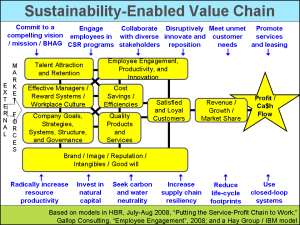The Sustainability-Enabled Business Value Chain

In my September 21, 2010 blog, I synergized a generic business value chain. It’s based on several other models and frameworks, and represents the most important elements from each. Why would sustainability champions care? When selling sustainability strategies to business leaders who are preoccupied with ensuring that every link of their value chain is optimized, we need to meet them where they are.
We need to relate our propositions to their business priorities, and show them that our recommendations will help them beat their competitors. By showing how sustainability-related strategies are helpful to key elements in their current business model, we gain their support and accelerate their adoption of sustainability-based approaches. We make sustainability relevant.
A 15-link generic business value chain
Let’s start with the plain-vanilla business value chain which we composed last week, shown in the adjacent slide. Its 15 elements are what it takes for any company to be successful. It is generic—it applies to any for-profit company, in any industry, anywhere. Do you want to start a company? Do you want it to be successful? Be good at each link in the value chain and you will succeed. The value chain is only as strong as its weakest link, so sustainability champions need to show how sustainable practices strengthen one or more links. Let’s look at a couple of models which highlight that dynamic.
The CSR activity value chainThe 2008 winter issue of the MIT Sloan Management Review included an article, “Using CSR to Win the War For Talent,” by C.B. Bhattacharya, Sankar Sen, and Daniel Korschum. Their CSR Activity Value Chain is in the adjacent slide.
It shows how employees identify with their company when they participate in the company’s corporate social responsibility (CSR) activities which they personally care about—the “company-cause fit” applies.
They are proud to work for the company. They are more committed to it, more loyal, and more productive. This is all about why employee voluntary participation in CSR activities contributes positively to the “Employee Engagement, Productivity, and Innovation” link in the generic business value chain.
The 11-link sustainability value chainA more comprehensive sustainability-energized value chain was suggested in the 2009 MIT Sloan Management Review special report, The Business of Sustainability Report. It contains findings and insights from the first annual Business of Sustainability Survey of 1,500 corporate executives and managers.
Its right-hand column caught my eye—it shows how sustainability efforts assist critical links in the value chain. It helps connect sustainability strategies with business priorities. Neat!
The sustainability-enabled value chainBuilding on the ideas in the above two models, here is an annotated version of my 15-link generic business value chain, now showing how smart, sustainability-based approaches enable the value chain. Consider it an appetite-whetter.
It prompts questions about exactly how each of the 12 blue sustainability-related strategies improves the yellow and green links in the business value chain.
It reinforces a fundamental insight: social and environmental initiatives are not something a typical company pays attention to out of the goodness of its heart—they are business imperatives if a firm wants to win in today’s game of business.
The sustainability-enabled value chain provides a framework for the business case for sustainability. The benefit of sustainability initiatives is that they are good for business. Their co-benefit is that they are also good for the environment and society. What’s not to like?
Bob
The PowerPoint slides used above are from my Master Slide Set.
Please feel free to add your comments and questions using the Comment link below.







Comments are closed.